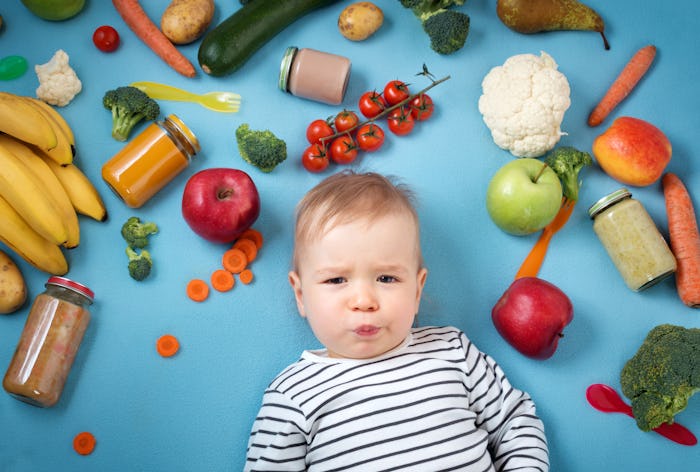Life

This Is The Perfect Snack Menu For A 1-Year-Old
By their first birthday, your toddler is likely enjoying at least three square meals a day, soaking up vitamins and calories (and dinner-time conversation) for all that learning and growing still to come. Can you believe that just a year ago she was light as a feather, and living on hummingbird sips of early breast milk or newborn formula? Now she seems to have the metabolism of a baby Ferrari — and you’re wondering what kind of snacks to serve between meals. What kind of snacks should a 1-year-old eat? The toddler and baby food aisle is a vast ocean of brightly colored choices, but which are healthiest for your child?
According to Tania Koerber, RD, LD/N, and a Board Certified Specialist in Pediatric Nutrition (CSP), toddlers need loads of calories for proper development, yet can only eat small amounts at a time. As a result, "A typical toddler’s meal pattern consists of five to six small meals. It's important however to start using healthy snacks at a very young age: fruit, yogurt, low-fat cheese, lean proteins like chicken, turkey, ham, eggs, and whole grain cereals or crackers," she tells Romper.
Over an email interview with Romper, nutritionist Ilyse Schapiro agrees that snacks should be healthy, and as unprocessed as possible. She also cautions against letting children fill up on too many cracker-based snacks, which might interfere with meal times, and also recommends "fruits, plain veggies, veggies with hummus or guacamole," and protein-rich yogurt and cheese. Schapiro also reminds parents that your 1-year-old needs 7 milligrams of iron a day, so load up on meats, seafood, dark leafy greens, and iron-fortified cereals. "Serve iron-rich foods with foods rich in vitamin C, such as tomatoes, broccoli, oranges, and strawberries," suggests Schapiro, because "vitamin C helps the body absorb iron."
In The Science of Mom, Alice Callahan, PhD, noted that the pre-packaged snacks for older babies and toddlers often contain some hidden dietary hazards. The author described finding a toddler turkey stew that included cornstarch, tapioca starch, and salt — unnecessary fillers without nutrients to speak of. If you're buying snacks, read labels carefully, and be on the look out for hidden sources of added sugar.
Toddlers learn a lot from early eating experiences. As Koerber notes, your child needs exposure to new textures (so a parade of purées might not cut it anymore). "A 1-year-old should be eating the same foods mom and dad eat," she explains, but cautions parents to be aware of choking hazards, like nuts, seeds, and dried fruit, and advises cutting food into manageable sizes.
At snack time, have fun introducing your burgeoning gastronome to lots of new foods. Get to chopping those fruits and veggies, and don’t forget sources of protein and iron like fish, beans, and lean meats. Snacking on whole foods is likely cheaper than buying pre-packaged snacks off the shelf, and almost certainly more nutritious, too.